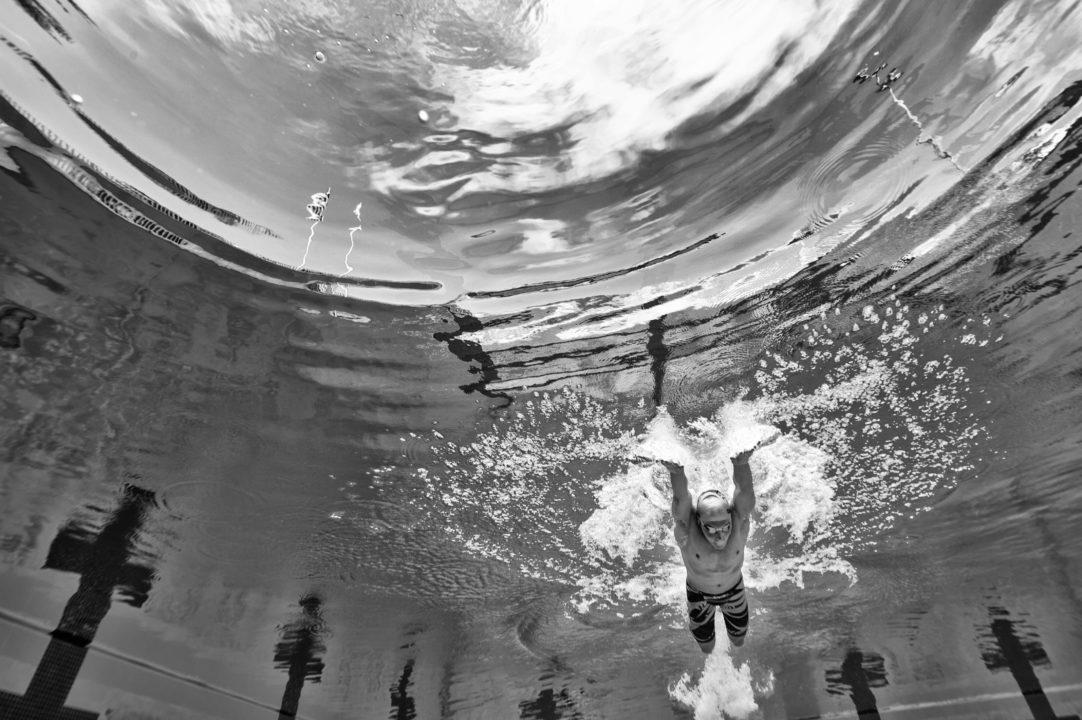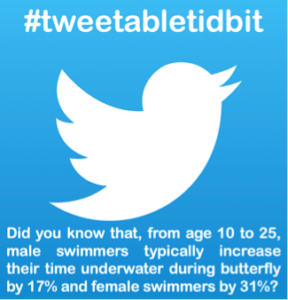Greetings swimmers, coaches, and swimming enthusiasts! We are back with another installment of the TritonWear Analysis series.
Previously, the TritonWear team analyzed freestyle, backstroke, and breaststroke, and discussed the effects of increasing age, height, and ability on swimmers’ stroke efficiency. Today TritonWear turns to the fourth and final stroke, butterfly, and asks: As swimmers grow older and gain more experience, how do these changes affect their butterfly stroke count and time underwater?
Butterfly Breakdown
To address this question, TritonWear examined data from 842 male and 898 female swimmers (ages 10–25 years) who swam butterfly in 25m pools using Triton Units to collect swimmers’ stroke information.
For the other three strokes, TritonWear focused on the significance of stroke rate and distance per stroke (DPS). However, for butterfly, TritonWear wanted to investigate other helpful metrics involved in butterfly success, including stroke count and time underwater.
Stroke Count
As you can see from the graphs below, both male and female swimmers typically decrease their average number of butterfly strokes per length as they grow older:
| Male Swimmers | Female Swimmers |
| Decrease their average number of butterfly strokes per length from 12.9 (at age 10) to 8.9 (at age 25) | Decrease their average number of butterfly strokes per length from 12.7 (at age 10) to 10.0 (at age 25) |
Based on this information, the logical conclusion is that if swimmers are decreasing their average number of butterfly strokes per length as they age, then they must also be improving their distance per stroke (which is consistent with the freestyle, backstroke, and breaststroke findings) and/or increasing their time underwater.
Time Underwater
When the TritonWear team reviewed the amount of time that swimmers spend underwater during butterfly, they discovered that both male and females increase their underwaters significantly from ages 10–25:
| Male Swimmers | Female Swimmers |
| Increase their time underwater (while swimming butterfly) from 3.33 seconds (at age 10) to 3.87 seconds (at age 25) | Increase their time underwater (while swimming butterfly) from 3.30 seconds (at age 10) to 4.33 seconds (at age 25) |
Although this increase in time spent underwater during butterfly may seem relatively small, this change does represent a significant proportional increase; from ages 10-25:
- male swimmers typically increase their time spent underwater by 17%, and
- female swimmers typically increase their time spent underwater by 31%.
So, if both male and female swimmers are decreasing their stroke count while increasing their time underwater, then these swimmers are also, ideally, improving their underwater speed relative to their overwater speed.
Time Underwater as a Percentage of Split Time
As swimmers become faster, their times drop (i.e. they take a shorter amount of time to cover the same distance), yet they tend to spend a greater portion of this shrinking time under the water.
So, TritonWear decided to look at time spent underwater as a percentage of total split time to learn about the effects of swimmers staying underwater relatively longer.
| Male Swimmers | Female Swimmers |
| Increase their time spent underwater as a percentage of total split time (while swimming butterfly) from 15.7 % (at age 10) to 24.6% (at age 25). | Increase their time spent underwater as a percentage of total split time (while swimming butterfly) from 15.1 % (at age 10) to 25.5% (at age 25). |
What we learn from these findings is that, when swimming butterfly, young swimmers spend most of their time above the water. However, as swimmers grow older, they further develop their underwater skills (e.g. push off strength, tight streamline, strong dolphin kicks, etc.), which become increasingly important components of butterfly races.
Conclusions & Recommendations
When swimming butterfly, young swimmers spend less time underwater and more above water, which corresponds to higher stroke counts. As swimmers become older and more experienced, they tend to increase their time underwater and decrease their time above water, which leads to a drop in stroke count.
One goal for swimmers is to work towards improving their underwater speed and then gradually increase their time underwater as a percentage of their overall split.
| Male Swimmers | Female Swimmers |
| Should aim to increase:
(1) their time underwater by roughly 1 tenth of a second every 2.5 years, and (2) their percentage of time spent underwater by approximately 0.6% per year. |
Should aim to increase:
(1) their time underwater by roughly 1 tenth of a second every 1.5 years, and (2) their percentage of time spent underwater by approximately 0.7% per year. |
Lastly, one important note is that swimmers should not seek to extend their time spent underwater simply for the sake of hitting particular targets; once a swimmer’s underwater speed drops below their swimming speed, they are probably missing out by staying underwater. When swimming butterfly, extending time spent underwater is beneficial in conjunction with improving underwater speed. As swimmers gain experience, they will continue working towards generating more speed through strong push-offs, efficient streamlining, and effective dolphin kicks.
Please visit the TritonWear website for tips on how to increase butterfly speed and improve push-off strength.
Learn more about how you can improve different areas of your swim such as stroke technique, turns, and more, in this comprehensive guide on How to Swim Faster.
VISIT THE TRITONWEAR HQ
FOLLOW US ON INSTAGRAM
LIKE US ON FACEBOOK
FOLLOW US ON TWITTER
Tritonwear is a SwimSwam partner.







I wonder if time underwater keeps increasing after age 25
Imagine 100 year olds doing the 200 fly completely underwater!
At age nearly 60+ I can assure you my body says “surface, surface, surface!!!” like a panicked submarine commander off the last wall of a typical 200 fly
Lol . I obviously meant up to age 30 or so . Didn’t think I had to clarify